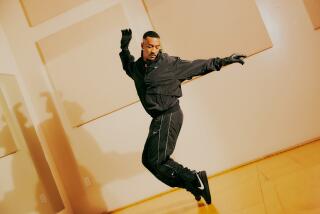Ecsntrcs look to inspire at Hip Hop International in Las Vegas
It was a simple question: Why does he dance?
Christian “Crane” Sekhanan got philosophical.
“Inspiration is the consumer product of hip-hop dancing. If you think about it, it’s really inspiration management. You do something like that so that other people will pick up your spirit. It’s contagious, and that’s what you want for them.”
Sekhanan and the Ecsntrcs are just a few of the record 3,500 dancers from 48 nations that have funneled into Las Vegas this week for Hip Hop International’s USA and World Hip Hop Dance Championships and World Battles.
Dozens of dialects are spoken, different music is played and numerous dance styles are on display in the halls of the Red Rock Casino, Resort and Spa but there are a few qualities that unite them all: a love of dance, passion and a desire to inspire.
Sekhanan might have one of the most inspirational stories of the competition -- but he doesn’t want to talk about it.
As the founder and choreographer of Ecsntrcs, his comments and quotes are reserved for what his group is trying to do, both in competing and in terms of why the Covina, Calif.-based dance crew came together in the first place.
“We like to believe that we represent the people that aren’t supremely talented. I feel like it gives a lot of people hope that through ingenuity or trying to be different or trying to be new, that there’s always room for you despite gaps in levels of talent,” says Sekhanan.
At the 2013 competition, the crew got to the finals but did not win the gold medal. During one performance, eyebrows were raised when a cane was brought onstage to help Sekhanan balance.
Appearing to be in pain, Sekhanan gave an inspirational speech about the crew’s time there and the friends they had made, making a fleeting reference to muscular dystrophy. The crew was cheered and walked offstage.
Sekhanan does not discuss what ails him. It may not affect his choreography or how good his crew is in the competition, and it probably does not help when being judged against supremely talented and athletic crews. But it touches others.
Karen Schwartz, one of the founders of Hip Hop International, recounted walking with the crew after a performance in the 2013 competition.
“People would turn and reach out to shake his hand, or just reach to touch him,” said Schwartz. “It was a great routine, but it also moved others. I was almost in tears.”
A crewmate, Domynyque Johnson, a.k.a. Tygress, is often by his side. Though, as she says, “You won’t know he’s in pain until he tells you,” she sees how it affects people.
“Some people take it to the extreme. They see the pain that he goes through, and it gives them no excuse. You see a man in this much pain, but he’s going up there doing something he loves,” says Johnson.
“[It] makes you look back on anything you’ve ever complained about in life. Not wanting to go to school because you’re sick. Not wanting to go to work because you don’t like your boss. Just all of the petty excuses you ever told yourself. And then you see him.”
The Ecsntrcs are back again in 2014 with an individual style that is not the typical bravado-filled hip-hop routine performed by many dancers. More well-known now, the crew remains tight-knit and its motivation to inspire through dance remains strong.
Sekhanan still does not wish to discuss what he is going through; he says it draws attention away from what he believes the group is trying to accomplish.
“We try our best to inspire, but I feel like what I go through personally, it’s not necessarily the biggest cause for our team,” says Sekhanan.
“Choreographers have come up to me during the competition just last night, and they see the kind of innovations and risks that we’re taking. In a competition like HHI, there can be a .1 difference in winning. We tried very hard to break the usual HHI mold -- which was nerve-wracking.
“So, one of the greatest inspirations, I believe, that we give to the dancers here is that we take that risk,” Sekhanan said.
More to Read
The biggest entertainment stories
Get our big stories about Hollywood, film, television, music, arts, culture and more right in your inbox as soon as they publish.
You may occasionally receive promotional content from the Los Angeles Times.







